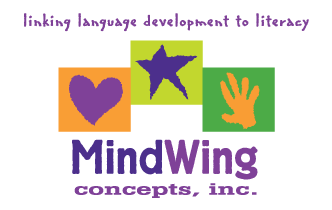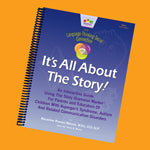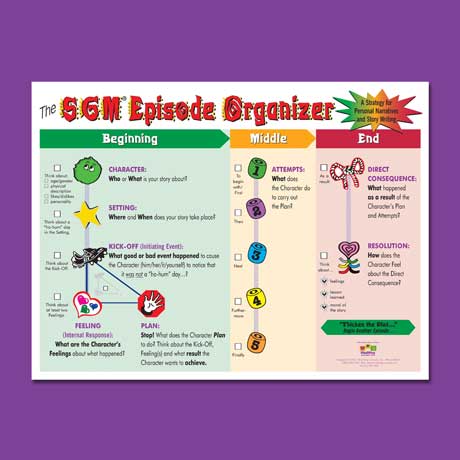Secure Checkout. FREE SHIPPING for Continental U.S. Orders over $60.
Menu
-
- Home
-
About Us
-
The Approach
-
Linking Language & Literacy
-
Professional Learning
-
Learning Resources
-
SHOP
-
Blog
-
- About MindWing
- Our People
- Contact Us
- Your Account
- Login
-
United States (USD $)

Secure Checkout. FREE SHIPPING for Continental U.S. Orders over $60.
The Zimmer Twins and Stepping Up Narrative Complexity!
March 17, 2011
I am going to open this post with a language sample obtained from a fifth grade student in 2006, an attempt to retell an episode of the series Full House.
And um something that happened was when this girl named Michelle and this guy Jesse, it was Michelle’s birthday. And Jesse and Michelle got stuck in a gas station and she missed her party.
And um they were there all day, but then finally it opened the next- no it opened a lot later. So um they went back to the house and they had their party and she got an elephant and she got to ride it and all her friends and she got, she felt better. And that’s it...

Interactive, Visual Resources to Complement Feelings Instruction (Internal Responses)
January 31, 2011
 As stated so well in It’s All About The Story, Book I of MindWing’s Autism Collection, “Tuning into one’s own Feelings as well as the Feelings of Others is extremely problematic to children with autism. The book provides visual flip charts, discussion prompts and an introduction to the Six Universal Feelings (happy, sad, mad, scared, surprised and disgusted), as well as ways to move beyond those Universal categories to more advanced feelings vocabulary—all of these resources give SLPs a great place to start...
As stated so well in It’s All About The Story, Book I of MindWing’s Autism Collection, “Tuning into one’s own Feelings as well as the Feelings of Others is extremely problematic to children with autism. The book provides visual flip charts, discussion prompts and an introduction to the Six Universal Feelings (happy, sad, mad, scared, surprised and disgusted), as well as ways to move beyond those Universal categories to more advanced feelings vocabulary—all of these resources give SLPs a great place to start...
Kick-Off the Kick-Off
January 12, 2011

Is Maryellen Actually “Maryellen Who?”
December 16, 2010 1 Comment
 Theodor Seuss Geisel, better known to the world as Dr. Seuss, was born in 1904 on Howard Street in Springfield, Massachusetts – which is right around the corner from MindWing’s office. The Dr. Seuss National Memorial Sculpture Garden is located at the Springfield Museums near our office as well. The influence of Ted’s (Dr. Seuss’) memories of Springfield can be seen throughout his work.
Theodor Seuss Geisel, better known to the world as Dr. Seuss, was born in 1904 on Howard Street in Springfield, Massachusetts – which is right around the corner from MindWing’s office. The Dr. Seuss National Memorial Sculpture Garden is located at the Springfield Museums near our office as well. The influence of Ted’s (Dr. Seuss’) memories of Springfield can be seen throughout his work.
In keeping with the spirit of the holiday season, we wanted to share a lesson idea from MindWing’s book: East Meets West for the Holidays by Maryellen Rooney Moreau and Judy K. Montgomery. This lesson is based on one of Dr. Seuss’ most beloved holiday stories: How the Grinch Stole Christmas.

Comprehension Involves More Than Just the Beginning-Middle-End of a Story
November 08, 2010

This is a MindWing Concepts Map of the components of a story taking into consideration “story grammar.” It is called “The SGM® Episode Organizer.” The story grammar components, making up the beginning/middle/end of a story are shown as icons. The Character, Setting, Kick-off (problem or excitement), Feeling and Plan are in the beginning. The actions (attempts) to carry out the plan make up the middle and the Consequence and resolution make up the end.

Use Google Search Stories tool to develop narrative and expository language
October 12, 2010
Every year during the Superbowl, a few commercials stick out from the sea of repetitive beer, snack food, and summer blockbuster ads. This past year, one of the best was Google’s Parisian Love ad, which told the story of an American’s romance with a French woman in a simple and brilliant way, as an unseen character “Googled” various search terms that reflected events in his life. A follow-up ad about a girl switching schools, which I never saw aired, would be even more relatable for kids and is definitely a great model of a complete episode.
These commercials were so popular that Google created a wonderful tool that allows users to make their own Search Stories. Simply pick your search terms and the type of search you want shown in your movie (e.g. web, image, product, map, etc), select the music and upload to a YouTube account (if you have Gmail, you already have a YouTube account)...
